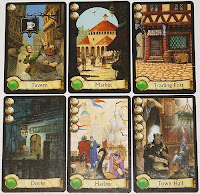
My wargame club recently began its fall project and my role is to paint the small metal soldiers that will represent the French troops. It seems that to depict these soldiers I'll have to paint several hundred tiny metal men. As I tried to swallow that task I reflected that miniature wargaming certainly has a significant built-in barrier to new players. How do you welcome interested people and then suggest that they launch into such a potentially time-consuming hobby? One answer is of course that it's fun to paint tiny metal figures! Another answer may lie in boardgames that act like miniatures games but without the ridiculous time investment.
Command and Colors: Ancients (C&C) is one such example.

In a game of
C&C each player is in charge of an army and their role is to sweep aside or defeat the opponent's army. Instead of a million metal men the players use wooden blocks with illustration of soldiers, horses, or elephants on their sides. A player's unit of Numidian cavalry might be depicted by three blocks with pictures of men on horseback on them, for example. The players lay out their armies on a board marked with spaces. Then in a given turn a player might move some of their units several spaces across the board, and if they're close enough to the enemy, "battle" them by rolling dice. Lucky die rolls might cause the opponent to retreat or disappear. If the attacker is unlucky the opponent may be given a chance to fight back. The turns alternate and each player gets a chance to move units, maneuver, and attack as best they can. Usually a game ends when one army has lost a good number of units.
C&C has a few rules that keep the play simple but satisfying. Both

players have a hand of cards. Players in charge of historically better led armies have more cards in their hand at any time. In their turn a player chooses a card, places it before them, and follows the instructions on it. Cards usually allow you to move a certain number of troops on a certain part of the board - "Move two units in the center of the board," for example. The cards are dealt randomly so you may not have the exact card you want, rather you just have to make due. For example, you may have powerful troops on the right and have to wait a while until dealt a card allowing you to move troops on the right. The limited set of options at any time is meant to simulate the limited control generals in Classical periods had over their troops. Giving one side more cards simulates the higher quality of leadership they had in that battle.
C&C includes a dozen or so sample scenarios based on real historical battles between Rome and Carthage. Players may command spear armed infantry, bowmen, chariots or elephants. These two elements contain both the strengths and weaknesses of the game. In terms of weaknesses
C&C is going to be pretty dull to anyone not interested in the battles of ancient Rome. Hard as it is to imagine, some teens and adults may not care a whit about such things, or would rather be battling space marines or sherman tanks. This game is obviously wasted on anyone disinterested in ancient battles.
In terms of strengths, then, this game is a fantastic simulation and ideal for anyone
with an interest in ancient battles. In summary,
C&C illustrates well a variety of factors which were crucial in these contests. We see light cavalry zipping around the board but running the risk of retreating off the map at some inopportune moment. We see the importance of maintaining a strong battle line. We see elephants running rough over formed troops but vulnerable to light infantry and slingers. Players will tend to win battles if they use their troops in their historic role- skirmishers in front, flanks protected with cavalry, archers disrupting enemy lines, and so on. New players may not know any of these things in their first game but after several plays they'll have received a crash course in ancient history.
One other drawback of note is
C&S' card system. It's not unreasonable that ancient generals had some limits in their control of their own troops and one could imagine an army's wing sitting and picking their teeth rather than charging at some crucial moment. Nevertheless the card system does veer away from "simulation" and towards "game". Serious ancient battle wargamers may find it too game-y. Further, very casual or younger players may prefer a game in which they can move all their troops in each turn to their heart's content. I personally find the card system exciting and challenging but players looking for non stop charges and attacks may look elsewhere.
I would recommend
Command and Colors: Ancients for anyone with an interest in gaming ancient battles. I think it's a terrific game in it's own right and a fine introduction to tactical and miniatures gaming as well. The rule book is a bit long but the basic system is simple and should be approachable to interested teens and up. I got my copy for the Holidays, you might order yours from the Hobby Bunker in Malden.
Pros: simple, fast, great historical battle game
Cons: requires interest in historical battles
Beyond the Basics: multiple expansions exist and there's plenty of room for tactical improvement










